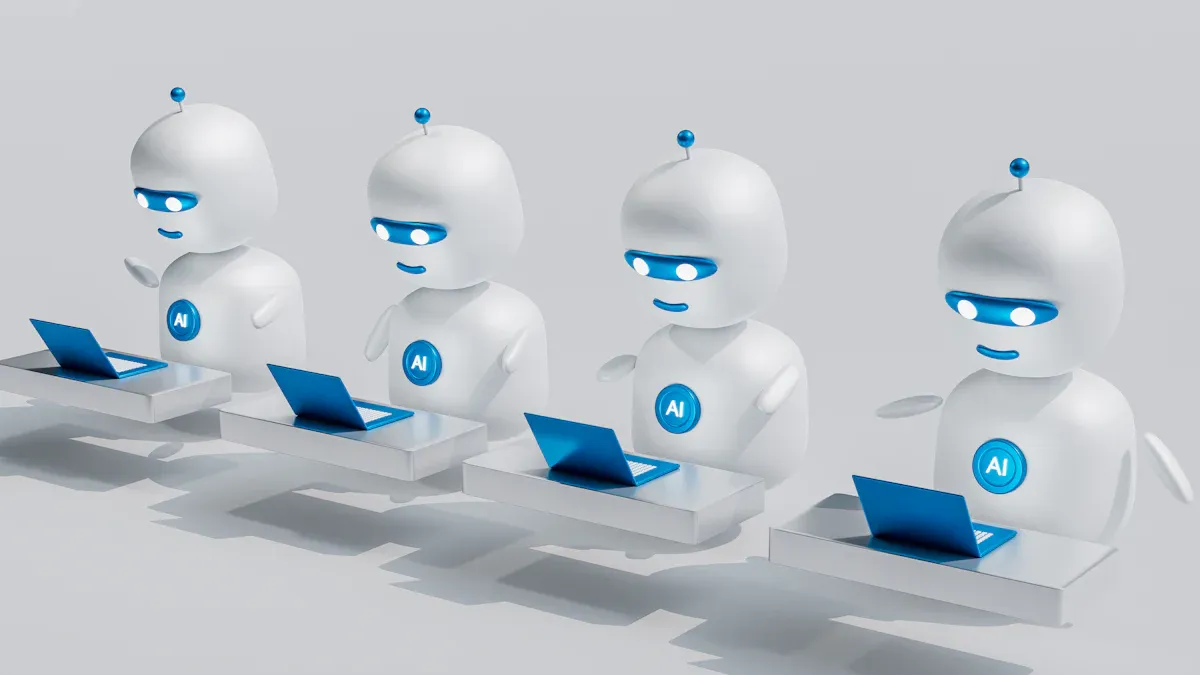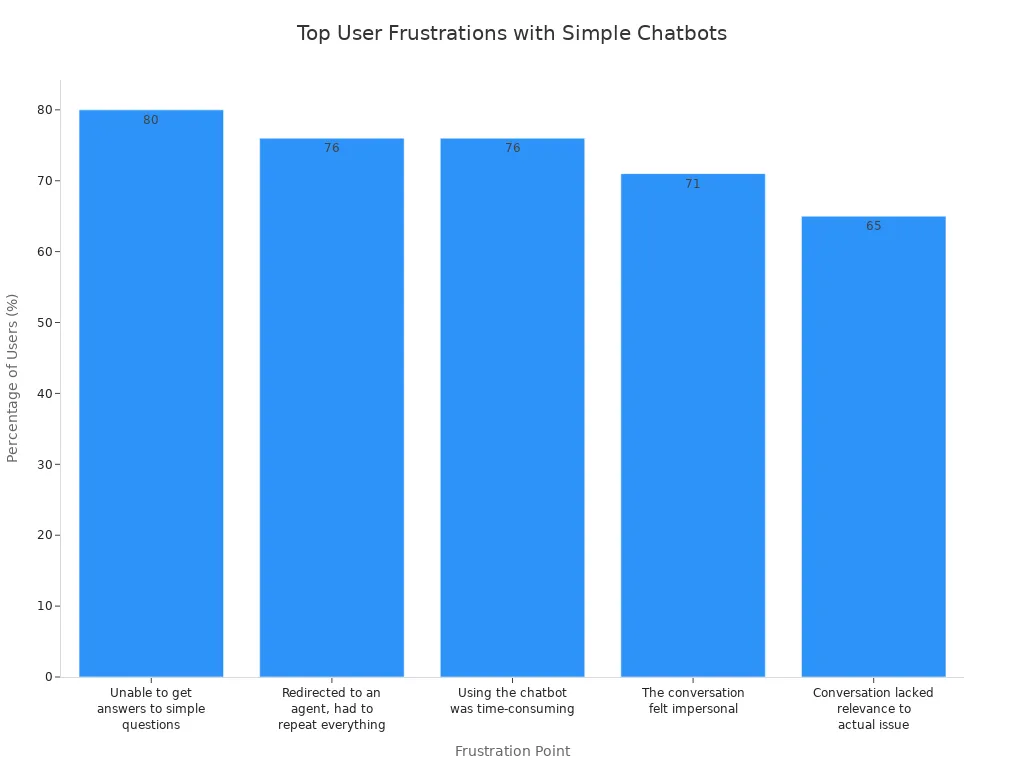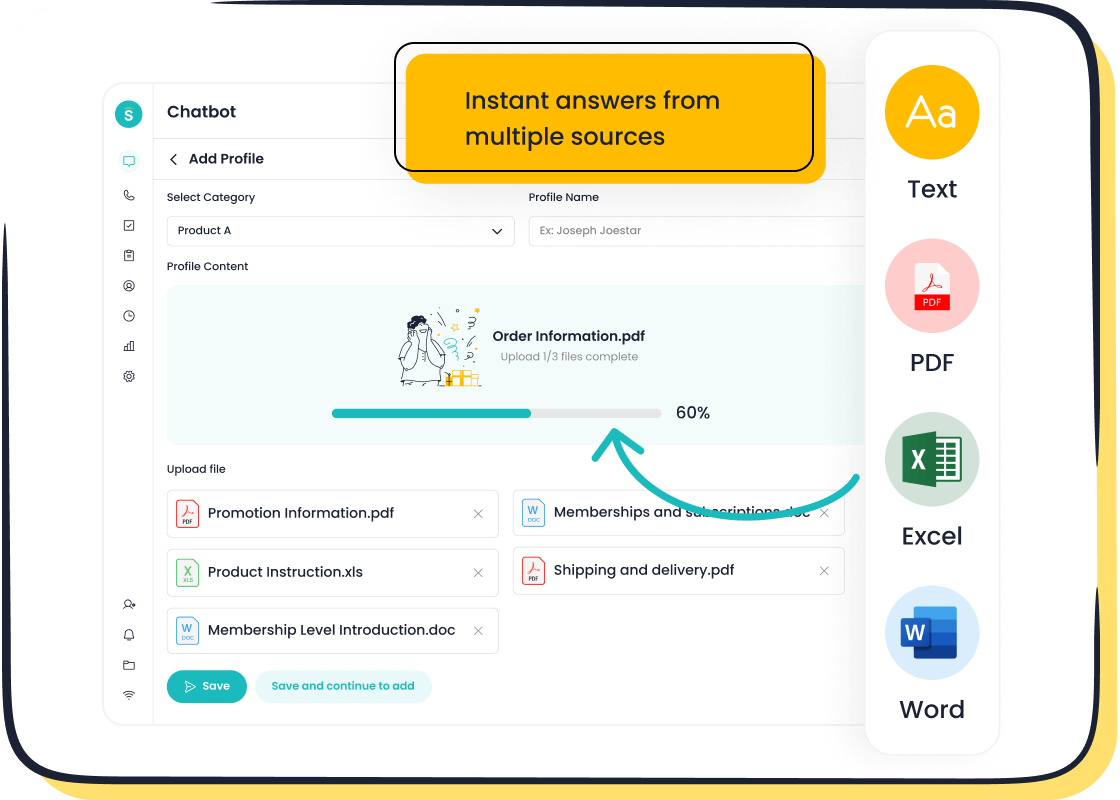Chatbot vs Conversational AI Explained Simply

Understanding the difference between chatbots and conversational AI is key. A simple chatbot acts like a vending machine with set responses. In contrast, conversational AI offers a truly conversational interaction, much like a helpful store clerk. A significant 74% of internet users prefer engaging with chatbots for simple customer service inquiries. This user preference fuels the growth of basic chatbots. Meanwhile, the rise of conversational AI is reshaping the industry. The Sobot call center, for example, integrates advanced AI. This understanding is vital as the market expands.
The conversational AI market shows incredible growth potential:
- Grand View Research projects a 23.7% CAGR from 2025 to 2030.
- IMARC Group forecasts 29.16% growth from 2025 to 2033.
- MarketsandMarkets predicts a 19.6% CAGR from 2025 to 2031.
- The Research Insights expects a 27.9% CAGR through 2030.
Solutions from Sobot, including Sobot AI, navigate the world of chatbot conversational ai.
Understanding Simple Chatbots

Simple chatbots operate on a straightforward principle. They follow predefined rules and scripts, much like a vending machine. A user makes a specific selection, and the chatbot delivers a pre-programmed response. This approach provides a solid foundation for understanding basic automation.
Core Mechanics and Features
The core of these chatbots relies on rule-based logic. Developers build conversation flows using decision trees or "if/then" scenarios. A decision tree starts with a single question. Each answer leads the user down a different branch toward a solution. These features guide users through a structured conversation.
Common examples include scripts for different business needs:
- Sales: These chatbots guide users to products or qualify leads.
- E-commerce: They provide information on orders, shipping, and returns.
- Education: These chatbots assist with enrollment or answer student FAQs.
This structured approach is a cost-effective first step into automation for many businesses. It provides a clear path for understanding customer interactions.
Ideal Use Cases for Basic Chatbots
Rule-based chatbots excel at handling high-volume, repetitive tasks. They are perfect for providing quick customer support. Businesses use these chatbots to answer frequently asked questions, check order statuses, or share business hours. Statistics show these chatbots can answer up to 79% of routine questions. They handle conversations from start to finish about 70% of the time. This efficiency makes them a valuable tool for freeing up human agents.
Limitations of Rule-Based Systems
The rigidity of rule-based systems is their main weakness. These simple chatbots often fail when users ask questions in unexpected ways. Basic chatbots have a high failure rate, with 60-80% of queries going unresolved. This limitation leads to significant user frustration. Many users abandon chatbots that cannot provide relevant answers.
A common complaint is the chatbot's inability to understand the user's actual issue. This lack of understanding forces users into frustrating loops or requires them to repeat information to a human agent.
The chart below shows the most common points of user frustration with simple chatbots.

These examples highlight the need for a better understanding of when to use a simple chatbot versus a more advanced solution.
The Rise of Conversational AI Chatbots

Conversational AI chatbots represent the next evolution in automated communication. These advanced systems move beyond rigid scripts. They use artificial intelligence (AI), machine learning, and Natural Language Processing (NLP) to create dynamic conversations. This conversational AI technology allows for a more human-like and helpful user experience.
The Power of AI and NLP
The engine behind conversational AI is its ability to understand human language. Natural Language Processing (NLP) gives AI the power to interpret user intent, context, and even sentiment. It breaks down text to analyze grammar and meaning. This allows conversational AI to understand what a user wants, even with typos or informal phrasing.
Deep neural networks power these AI-driven interactions. They help the conversational AI identify intent far more effectively than simple keyword matching. Key algorithms that enable this understanding include:
- Recurrent Neural networks (RNNs): These process conversational data in sequence to remember the context of the chat.
- Long Short-Term Memory (LSTM): This is a special type of RNN that recalls information for longer periods, improving the conversational flow.
These technologies work together, allowing conversational AI chatbots to learn and improve from every interaction.
Advanced Features and Capabilities
Unlike basic chatbots, conversational AI offers advanced features that actively help users. These AI-powered solutions can handle complex tasks and engage users proactively. Some examples include guiding visitors to the right products or capturing leads without needing a form. This level of interaction makes the conversational experience more valuable. For example, a sophisticated chatbot can complete a full transaction, like purchasing a ticket, within the chat window. These capabilities transform chatbots from simple Q&A tools into powerful assistants for sales and customer support.
Sobot's Impact on Customer Support

Sobot’s AI Chatbot is a prime example of powerful conversational AI in action. This ChatGPT-enabled chatbot is designed for superior customer engagement. It is multilingual and features a no-code, point-and-click interface, making powerful AI accessible to any business. This chatbot conversational ai solution does more than answer questions. It boosts productivity by 70% and increases conversions by up to 20%. By handling complex queries and providing intelligent assistance, Sobot’s AI chatbots empower businesses to elevate their customer support and drive growth.
Chatbot vs. Conversational AI: A Direct Comparison
Understanding the distinction between a simple chatbot and advanced conversational AI is crucial for any business. While both tools automate communication, their capabilities and impact on the customer experience differ significantly. This direct comparison breaks down the core differences to help you make an informed decision.
Underlying Technology
The foundational technology is the biggest differentiator in the chatbot vs. conversational ai debate. Simple chatbots operate on rule-based logic. They follow predefined scripts and decision trees, much like a flowchart. This "if/then" structure means they can only respond to specific commands or keywords they are programmed to recognize. These chatbots are static; a developer must manually update their scripts to change their behavior.
Conversational AI, in contrast, represents a major technological leap. It is built on machine learning and Natural Language Processing (NLP). This allows it to understand, interpret, and respond to human language dynamically. Instead of rigid rules, conversational AI uses complex algorithms and neural networks to grasp user intent, context, and even sentiment.
- Rule-Based Chatbots: These utilize pre-written scripts and are best for simple, transactional tasks.
- Conversational AI Systems: These are powered by AI and advanced models like Large Language Models (LLMs). They understand conversational nuance and continuously improve through training.
This advanced architecture allows conversational AI to handle complex requests without needing exact phrasing. The scalability also differs greatly. Rule-based chatbots are difficult to expand, as adding new rules is time-consuming. Conversational AI platforms are highly scalable, managing growing interaction volumes seamlessly.
Key Differences in Chatbot Conversational AI
Beyond the core technology, there are several key differences in how these two types of bots function. The implementation, cost, and data requirements vary widely. Simple chatbots have a quicker deployment cycle and a lower initial investment. Conversational AI platforms require a larger upfront investment and a longer setup process due to their complexity.
The table below highlights the key differences between the two technologies.
| Feature | Rule-Based Chatbots | Conversational AI |
|---|---|---|
| Technology | If/Then Logic, Decision Trees | AI, Machine Learning, NLP |
| Flexibility | Rigid, Follows Scripts | Adaptive, Understands Context |
| Training Data | None Required | Large Volume of Labeled Data |
| Implementation | Quick, Often No-Code | Longer, More Complex |
| Initial Cost | Lower ($30k - $200k) | Higher ($45k - $500k) |
These factors show that the choice between chatbots vs conversational ai depends heavily on a business's resources and goals. While simple chatbots offer a cost-effective entry point, conversational AI provides a more powerful, long-term solution.
User Experience and Personalization
The user experience is where conversational AI truly shines. Simple chatbots provide a basic, often impersonal interaction. They are stateless, meaning they treat every query as a new event and cannot remember past conversations. This lack of memory can lead to a frustrating customer service experience, forcing users to repeat information.
Conversational AI chatbots create a far more natural and personalized conversational journey. They use conversational memory to recall previous interactions, both within a single session and across multiple conversations. This allows the AI to provide contextual and relevant answers, making the user feel understood.
For example, Spotify uses AI to create personalized playlists, which boosts user engagement and loyalty. This level of hyper-personalization is a key strength of conversational AI.
This ability to deliver personalized responses has a direct impact on customer satisfaction. Research shows that mature AI adopters report 17% higher satisfaction scores. AI-driven personalization can also drive up to a 15% increase in revenue by creating a better customer experience.
Sobot's AI Solution for the retail and e-commerce industry is a powerful example of this technology in action. It offers a true conversational AI platform with omnichannel integration capabilities, allowing businesses to engage customers on chat, email, voice, and social media. This solution provides human-like interactions and ensures data privacy with GDPR compliance. By leveraging AI, businesses can deliver a superior, personalized conversational experience that builds loyalty and drives sales. The advanced features of this conversational AI technology provide a deeper understanding of customer needs.
Making the Right Choice for Your Business
Selecting the right automation tool is a critical decision for any company. The choice between simple chatbots and advanced conversational AI depends entirely on your specific business goals. This section guides you through assessing your needs, comparing your options, and preparing your customer service for the future. Making an informed choice ensures you invest in a solution that delivers real value.
Assessing Your Business Needs
Before choosing a technology, a business must first understand its own operational needs and customer interaction complexity. A simple framework can help evaluate these requirements. The L.U.R.O.I. model offers a structured approach for managing and improving conversational interactions.
| Step | Description |
|---|---|
| Listen | Actively pay attention to customer statements and emotions. |
| Understand | Clarify the customer's needs and the context of their request. |
| Respond | Provide clear and empathetic answers to the customer. |
| Optimize | Record insights gained and use them to improve existing processes. |
| Iterate | Refine the approach based on performance data and feedback. |
Using this model, a business can identify whether its primary goal is simple efficiency or creating advanced, personalized experiences. Key questions to ask include:
- What is the volume of our customer inquiries?
- How complex are the typical questions we receive?
- Is our main goal to reduce costs or to improve customer engagement and loyalty?
Answering these questions helps define the scope of the problem you want to solve. It clarifies whether a basic or an advanced conversational solution is the better fit.
Choosing Between Chatbots vs Conversational AI
Once you have assessed your needs, the choice between chatbots vs conversational ai becomes clearer. Simple chatbots are an excellent starting point for businesses focused on cost-effective automation for repetitive tasks. They excel at handling high-volume, straightforward inquiries like providing business hours or checking an order status.
In contrast, conversational AI is the superior choice for businesses aiming to deliver a sophisticated and personalized customer experience. This advanced AI technology handles complex, multi-turn conversations and understands user intent, making it ideal for sales, detailed support, and building customer relationships.
A powerful real-world example of this is OPPO's success with Sobot. The global smart device leader implemented Sobot's human-machine solution to manage high inquiry volumes. The results were transformative:
- The chatbot achieved an 83% resolution rate, handling most queries without human help.
- The company saw a 57% increase in its repurchase rate, proving that a great conversational experience drives loyalty and sales.
This case study demonstrates how a well-implemented conversational AI strategy can dramatically improve both operational efficiency and business growth. The right choice aligns with specific business goals, whether that is cost reduction or driving customer loyalty.
Future-Proofing Your Customer Service
Investing in customer service technology is not just about solving today's problems; it is about preparing for tomorrow's challenges. The field of conversational AI is evolving rapidly, with emerging trends that will redefine customer engagement. Future-proofing your customer support means choosing a solution that can adapt and grow with these advancements.
Key trends shaping the future of conversational AI include:
- Proactive Conversations: AI will initiate helpful interactions instead of just reacting to user queries.
- Hyper-Personalization: AI will use data to create deeply individualized conversational journeys for each user.
- Autonomous Agents: Advanced AI will manage complex tasks from start to finish with minimal human oversight.
- Governance and Compliance: As AI becomes more powerful, ensuring data privacy and ethical use is critical. Leading platforms prioritize compliance with regulations like GDPR through robust data encryption, anonymization, and access controls.
Choosing a platform like Sobot, which is built on a foundation of powerful and compliant AI, ensures your business is ready for the future. An adaptable chatbot conversational ai solution allows you to scale your customer service, integrate new technologies, and continuously improve the conversational experience. This forward-thinking approach protects your investment and secures a competitive advantage.
The debate over chatbots versus conversational AI is not about which is better, but which is right for a specific task. Simple chatbots are effective for basic, high-volume queries. For a truly personalized conversational experience, advanced conversational AI is the clear choice. This powerful AI technology transforms customer support and customer service. A superior conversational AI chatbot handles complex workflows and builds loyalty.
Ready to find the right solution for your business? Embark on your contact journey and explore Sobot's conversational AI today.
FAQ
What is the main difference in the chatbot vs. conversational AI debate?
The core difference is technology. Simple chatbots follow fixed rules and scripts. Conversational AI uses machine learning to understand language, context, and user intent. This allows for more flexible and natural conversations.
When should a business choose a simple chatbot?
A business should choose a simple chatbot for handling basic, repetitive tasks. They are ideal for:
- Answering frequently asked questions (FAQs)
- Providing business hours
- Checking order statuses
This choice is cost-effective for high-volume, low-complexity inquiries.
Why is conversational AI better for customer experience?
Conversational AI creates a personalized journey. It remembers past interactions and understands complex requests. This leads to higher customer satisfaction and can increase loyalty. It makes customers feel heard and understood.
Is conversational AI difficult to set up?
Modern conversational AI platforms simplify the setup process. For example, Sobot’s AI Chatbot offers a no-code, point-and-click interface. This feature allows businesses to design and deploy powerful AI solutions without needing programming experience.
See Also
Effortlessly Deploy Engaging Chatbot Examples for Your Website Today
Your Essential Guide to Selecting Optimal Chatbot Software Solutions
Simple Steps to Build an Effective Chatbot for Your Website
Seamlessly Integrate a Powerful Chatbot Onto Your Website
Crafting a Strategic Chatbot to Drive Your Website's Success
